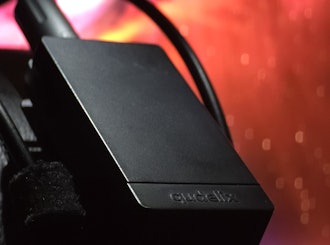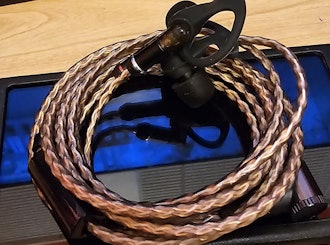Click to view our Accessibility Statement or contact us with accessibility-related questions.png?auto=format&fm=jpg&fit=fill&w=46&h=46&fill=solid&fill-color=fff&bg=fff&dpr=1&q=70)














.png?auto=format&fm=jpg&fit=fill&w=46&h=46&fill=solid&fill-color=fff&bg=fff&dpr=1&q=70)
Showing 1 of 126 conversations about:
SimonPac
2
Jun 1, 2018
bookmark_border
Balanced audio connections do not use the signal/power ground as one of the two wires required to convey a single (say left channel or right channel) audio signal. Instead each of the two balanced wires for a channel carries the same waveform but 180 degrees out of phase (phase inverted) with respect to the other, each waveform being of nominally equal amplitude. The main potential advantage is that the ground (0V) connection of the equipment is not carrying an audio input (or output) signal.
There is no inherent reason for balanced inputs to work better other than superior common mode interference rejection and the avoidance of ground loops. Neither possible problem is normally a major factor for domestic audio at line levels. If the amplifier is truly balanced throughout it is possible that signal current in the ground path will be reduced slightly, to the benefit of distortion but again this should not be an issue in well-designed equipment. A truly balanced throughout amplifier may generate a more complex distortion characteristic because it essentially contains two separate amplifier circuits, one handling the in-phase signal and the other the out-of-phase signal. Again, hopefully not a real issue.
A true balanced output stage will be able, potentially, to deliver twice the voltage swing and four times the power into a given load, for the same DC voltage used to supply the amplifier. A balanced headphone amplifier with a balanced headphone lead will reduce ground wire intermodulation of the channels, though only very slightly unless the lead, whether within the amp or the external lead, is of very poor quality, and carries the left and right channel grounds for a significant length.
The number of AC power transformers in a piece of equipment is entirely unrelated to whether the equipment is balanced in signal operation. Some equipment uses audio balancing input transformers to convert from balanced to unbalanced or vice-versa. These are normally very small and shielded magnetically and electrically.
A stereo DAC requires a minimum of 2 DAC circuits. A balanced stereo DAC requires a minimum of 4 DAC circuits. Many DAC chips contain more than one actual DAC circuit. The number of DAC chips is not a direct indicator of balanced or unbalanced operation.
Related Posts

LostnAmerica
Sound Signature of the Grell Project.
Wondering what type of sound signature the Drop Grell project headphones will have or trying to attain. Any update would be appreciated.
Apr 8, 2024

Fabulous
Looking for a gaming/content audio setup
Hello! I'm looking for recommendations on audio setups. I'd be planning on using it mostly for gaming. Preferably I'd like a pair of large closed back headphones since I have a big head and jaw. I'd also like to hear myself through my mic with mic monitoring. As far as budget goes, I don't really have one. But under 600$ would be nice. I can go higher if needed. The audio setup would be connected to a high performance PC. Thank you in advance for any recommendations!
Apr 4, 2024

1plsd
$10 Drop Coupon Email not sent?
Trying to buy some gear off Drop for the first time. I was told I would receive an email with a welcome to drop $10 off promo. I never received that email. Drop was able to send me emails for my login token and email for Password update. But for some reason the $10 off coupon was never sent to me.
Mar 31, 2024
Mr.Hazmat
What would be a good portable Dac/Amp to use with my HD6xx and Sony Xperia 1 V cell phone?
I am new to this hobby. I purchased a HD6XX and plan to use it with my Sony Xperia 1 V cell phone, that has a 3.5mm jack. I was wondering if I needed a portable dac/amp or just a portable amp and if so what would one recommend? Any assistance one could provide, would be greatly appreciated. Kind regards, Haz
Mar 7, 2024

JonathanWB
Invest in Balancing my HD6xx headphones?
Hi... I'm a songwriter/producer. I have Drop Senn HD6xx HPs. I just bought a Topping L30 II SE HP amp to enhance my monitoring. It honestly sounds pretty good. The audio interface I'm using (an Audient iD22) has balanced outs. For those of you who've listened to the HD6xx using balanced amps and cables, do you think I should invest in that kind of setup to take advantage of the Senns potential?
Feb 22, 2024
adiaz7531
B1 Bluetooth Music Receiver
Hello! Has the AudioEngine B1 Bluetooth Music Receiver ever been available here as a Drop?
Feb 15, 2024
Trending Posts in Audiophile

Simthaniel
Rigs
Modded headphones with qudelix at the core
When I received the Qudelix 5K, I had already modified a pair of Superlux HD-681 headphones. I previously soldered my own balanced connections to the drivers, providing multiple ways to connect and...
Apr 14, 2024

brothamike
A decent set of IEMs
I am in the midst of a 300 hour burn-in but, I will say I am enjoying how this set sounds so far. Before I received these which was btw late by a few weeks, I purchased a Sony/Kimber Kable MMCX...
Apr 12, 2024
merrick97
Should I exchange the PC38X for better headphones?
I bought the PC38X headphones FOR GAMING and they are great, but I have NO use for a Microphone since I don't do competitive gaming and I was wondering if there were better headphone options at a similar price without a headphone, where (presumably) more of the cost was put into making it sound better. I also find that my PC38X don't get quite as loud as I would like and I was wondering if a cheap amp like the iFi Go link would draw a little more volume out of my phones. https://www.amazon.com/dp/B0BN6MM822?psc=1&ref=ppx_yo2ov_dt_b_product_details I went with the PC38X since it was considered the best bang for buck headphones. I care most about using spatial apps like DOlby Atmos and DTS Headphone:X. Suggestions are welcome.
Apr 11, 2024

LostnAmerica
Sound Signature of the Grell Project.
Wondering what type of sound signature the Drop Grell project headphones will have or trying to attain. Any update would be appreciated.
Apr 8, 2024

Fabulous
Looking for a gaming/content audio setup
Hello! I'm looking for recommendations on audio setups. I'd be planning on using it mostly for gaming. Preferably I'd like a pair of large closed back headphones since I have a big head and jaw. I'd also like to hear myself through my mic with mic monitoring. As far as budget goes, I don't really have one. But under 600$ would be nice. I can go higher if needed. The audio setup would be connected to a high performance PC. Thank you in advance for any recommendations!
Apr 4, 2024

1plsd
$10 Drop Coupon Email not sent?
Trying to buy some gear off Drop for the first time. I was told I would receive an email with a welcome to drop $10 off promo. I never received that email. Drop was able to send me emails for my login token and email for Password update. But for some reason the $10 off coupon was never sent to me.
Mar 31, 2024

NMPacella
New here
Hello, I just joined, primarily for the audiophile products. Looking at purchasing the NHT C3 speakers for our new living room. Space is about 15 feet wide by 33 long and they will fire long ways. Space is just for general listening, music room with all equipment is downstairs, so hoping they will fill it with sound nicely. Cheers.
Mar 18, 2024


